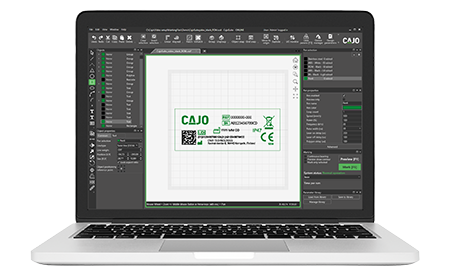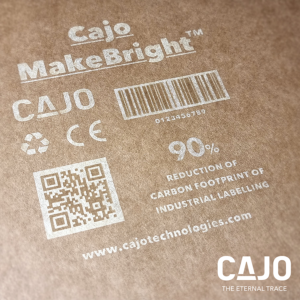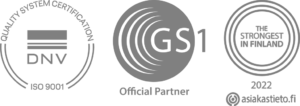Laser Marking – Basics (5 Application Examples)
Laser Marking is a marking method that uses a focused laser beam to alter the surface of a target. There are no additional materials used, just a laser beam. However, a laser marking system for industrial use is a comprehensive system of parameters, software, hardware, and laser marking device(s).
The laser marking device is naturally an important part of the laser marking system. However, hardware is just one part of a fully functional system.
Laser Marking Software is where you design what you want to mark, and also where you do all the technical configurations. In a perfect laser marking system, both the software and the hardware talk seamlessly together.
The following image is a view of our CajoSuite™ laser marking software. This is where the design is made, and also where all the configuration parameters reside.

(More information on laser marking software)
Laser Marking Process
When you have a laser marking or any marking requirement, the process typically goes like this:
- Define the Requirements: e.g. QR or data matrix codes, traceability markings, barcode, materials, volumes, sizes, etcetera. Possible applications include for example laser marking plastic in a cable factory, or more simple packaging laser marking, or perhaps a UDI marking application.
- Parameters and Configurations are set by laser marking professionals with years of experience.
- Design the Marking. Whatever you want to mark, you need to have a design first. This is done with the laser marking design software.
- Settings and Configurations are loaded into a Laser Control Board.
- Start the Production.
We believe it is important to master the entire laser marking process in order to get the best possible results, as efficiently as possible. Our laser marking technology starts from know-how from hundreds of industrial applications and continues with expert quality testing. Our laser marking technology is designed 100 % in-house, from the software to the control board, and to the laser marking devices.
Different Laser Marking Device Types
We divide the laser marking devices into three categories:
- Stand-alone laser marking systems
- Integrated laser marking systems
- Dedicated/Customized laser marking systems
Stand-alone laser marking systems work perfectly for more simple requirements, integrated laser marking systems form a part of a production line, and dedicated systems are typically custom-made for a very complex or otherwise not typical requirement.


Traceability and Materials
Product traceability requirements are one of the main reasons for laser marking growth. Permanent traceability applications with laser marking can work at high-speed production lines. The other reason for laser marking growth is the impressive range of materials it works with. These materials include but are not limited to:
- Steel
- Aluminium
- Titanium
- Wood
- Copper
- Ceramic
- Rubber
- Paper
- Cardboard
- Glass
- Plastic
Products or parts can be marked with text, serial numbers, or machine-readable data such as barcodes, Unique ID codes, 2D data matrix codes, QR codes, and graphics.

Laser Marking Application Examples
Laser marking works virtually for any industrial marking requirements you might have. Over the years, we have realized hundreds of different marking systems and applications. Here you have a list of a few examples we find particularly interesting.
Marking iLOQ keys
This project is quite interesting not only for its marking requirement but also for the integration we did for the customer’s ERP system. The laser marking system here works perfectly for product traceability. Each key is marked individually and they are 100% traceable back to the production line.
Read more: iLOQ – Electronic, plastic key laser marking
Marking Zinc metal bars
Occasional challenges in zinc bar production facilities are high surface humidity and temperature variation between 80 to 110 degrees Celsius. Laser marking technology proved that regardless of these challenges highly precise and abrasion-resistant markings can be carried out. In addition, the solution was fully automated with a robot supplied by our partner ABB.
Read more: Zinc Bar Laser Marking
Marking of Subsea cables
Creating permanent markings with good contrast on a yellow polyethylene (PE) plastic has been somewhat challenging until the laser solved it. integrated laser marking works now at 10m/s speed marking the cable every 120 degrees. One batch reaches 80 km of cable. 100.000 h of marking without maintenance.
Read more: Subsea Cable Marking
There are a lot more examples from different industries. Find more examples on our case studies page: All Case Studies
Stainless Steel Laser Marking
Sharpness and speed were the most important factors here. Even though, also our ability to laser mark vibrant colours on steel, titanium, and chrome without additives provided a singular benefit. We are able to permanently mark full-colour graphics directly on stainless steel blades.
The solution implemented was two Cajo laser marking systems configured with an automatically rotating table. Excellent speed and accuracy were obtained in the production process without machine maintenance or downtime.
Read More: Stainless Steel Marking
CO2 Laser Replacement – Cost Savings
Cost savings, flexibility, and marking speed were considered top features. Marking volumes are around 50 000 metal plates annually, and there can be over a dozen different marking plates for different components. Our laser marking solution speeded up the marking process by decreasing it to 1/3 of the time needed with the previous marking solution.
Read more: CO2 Laser Replacement

